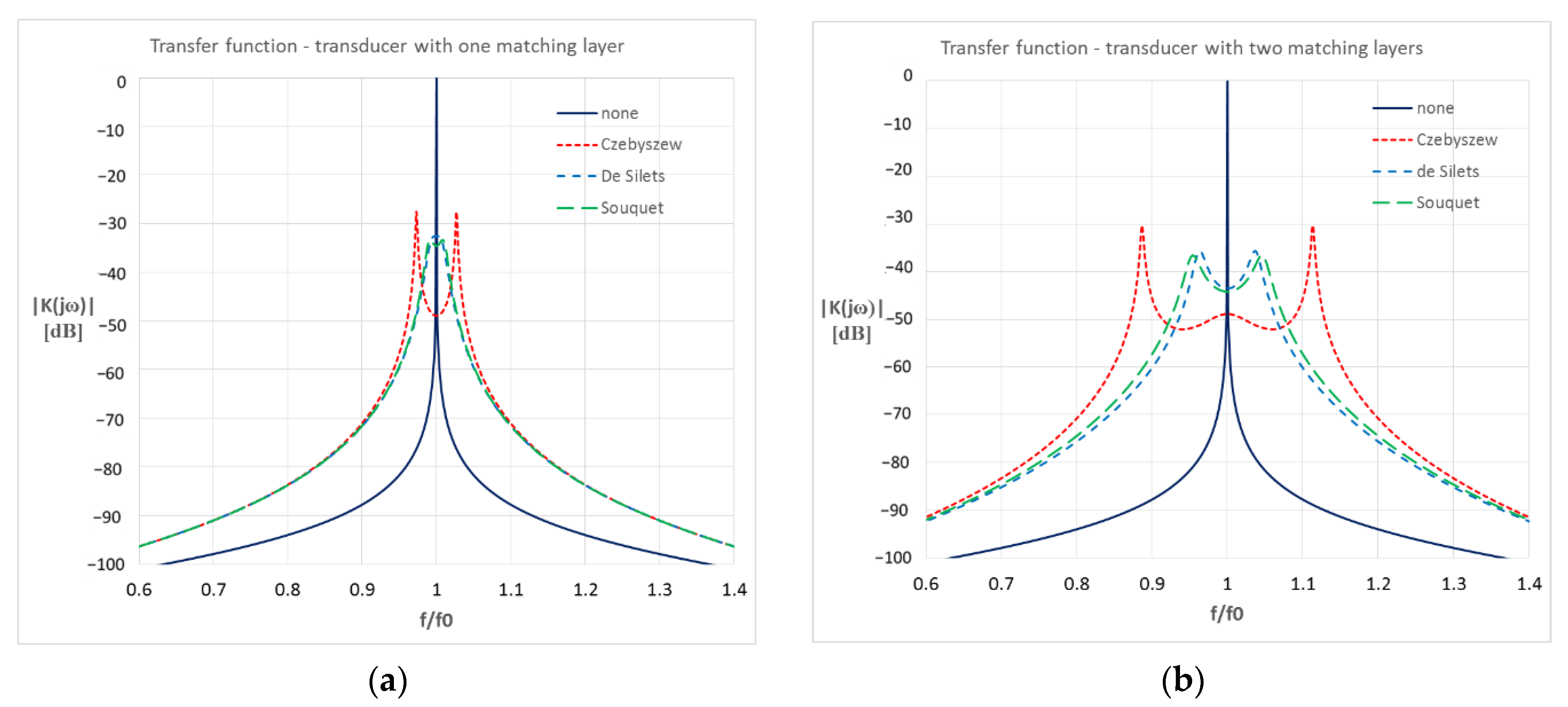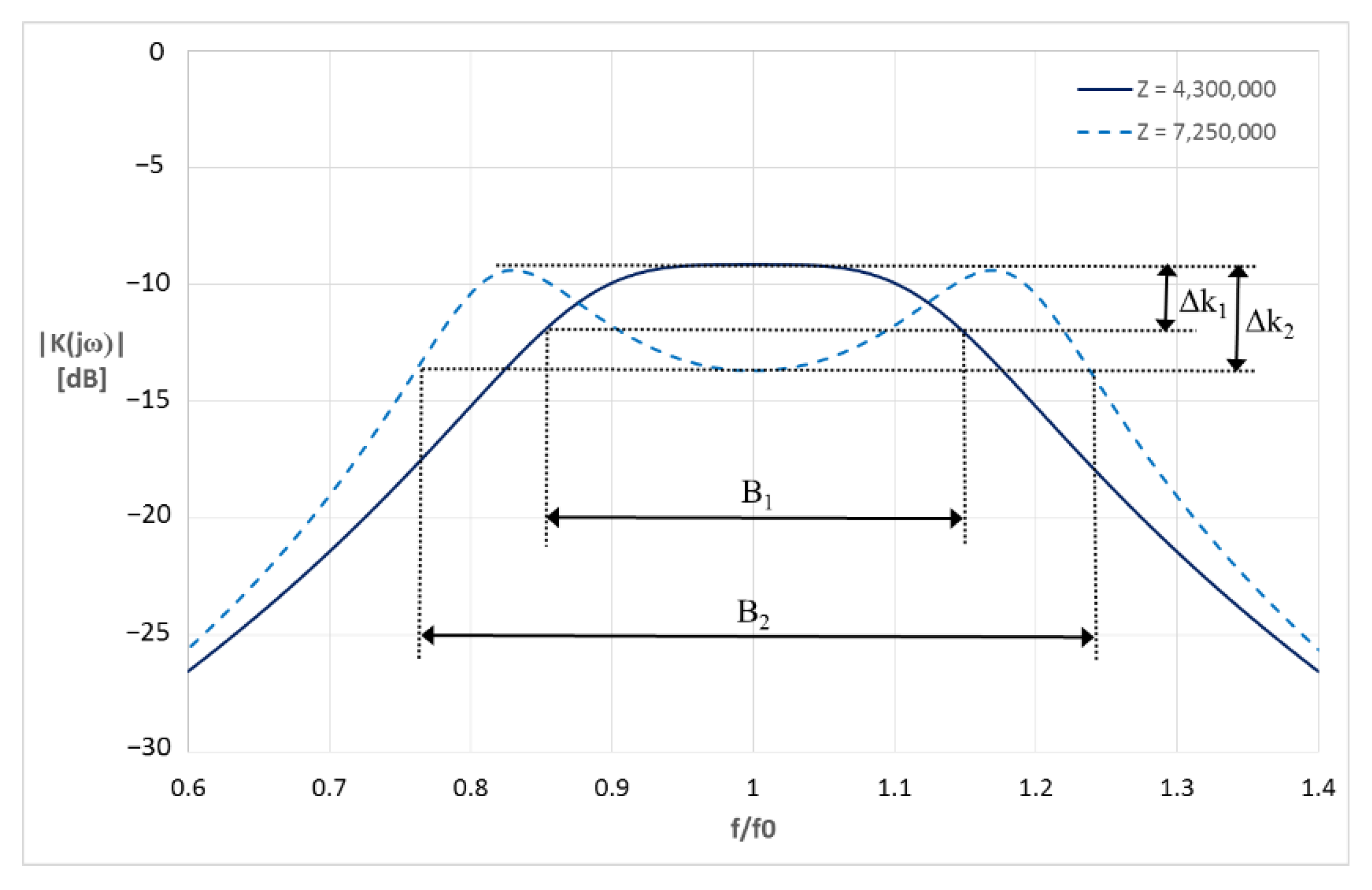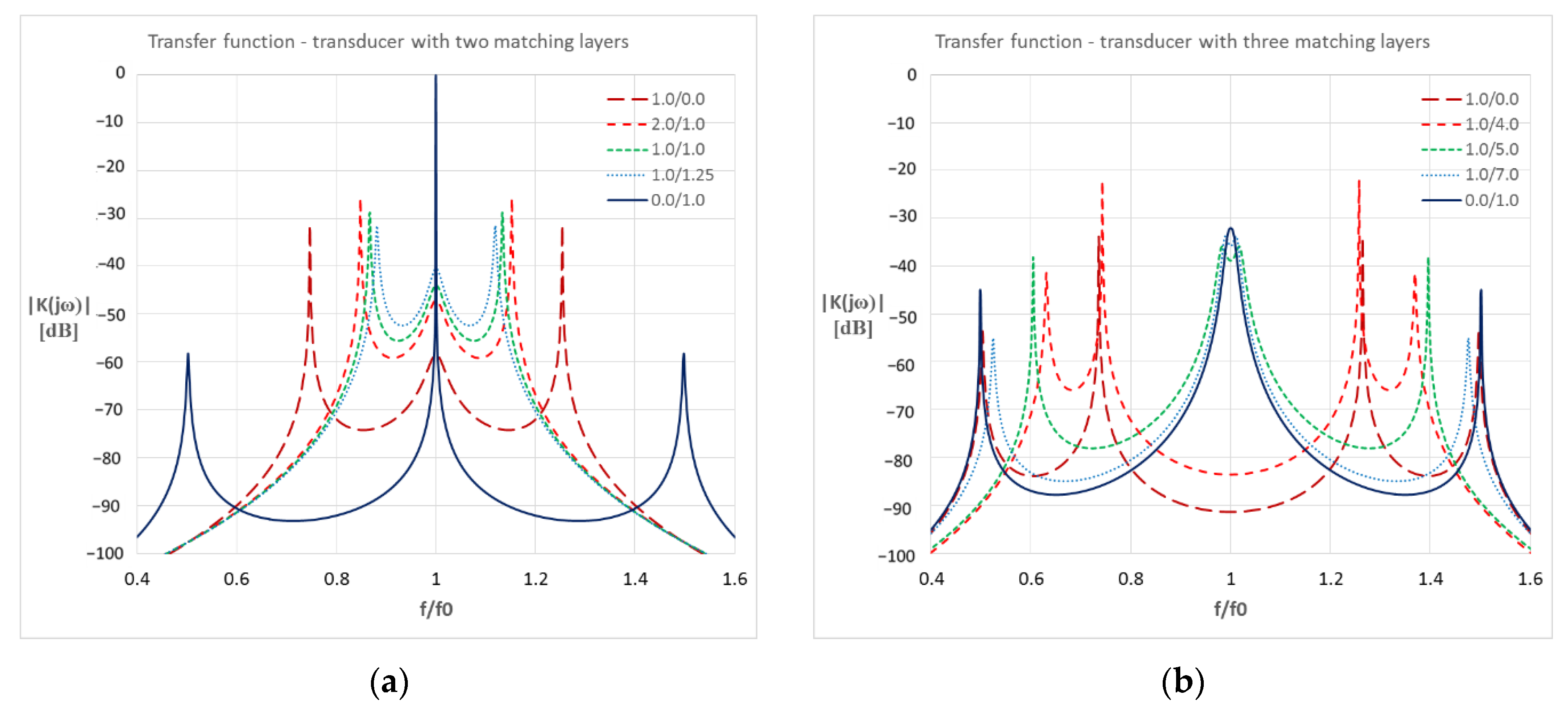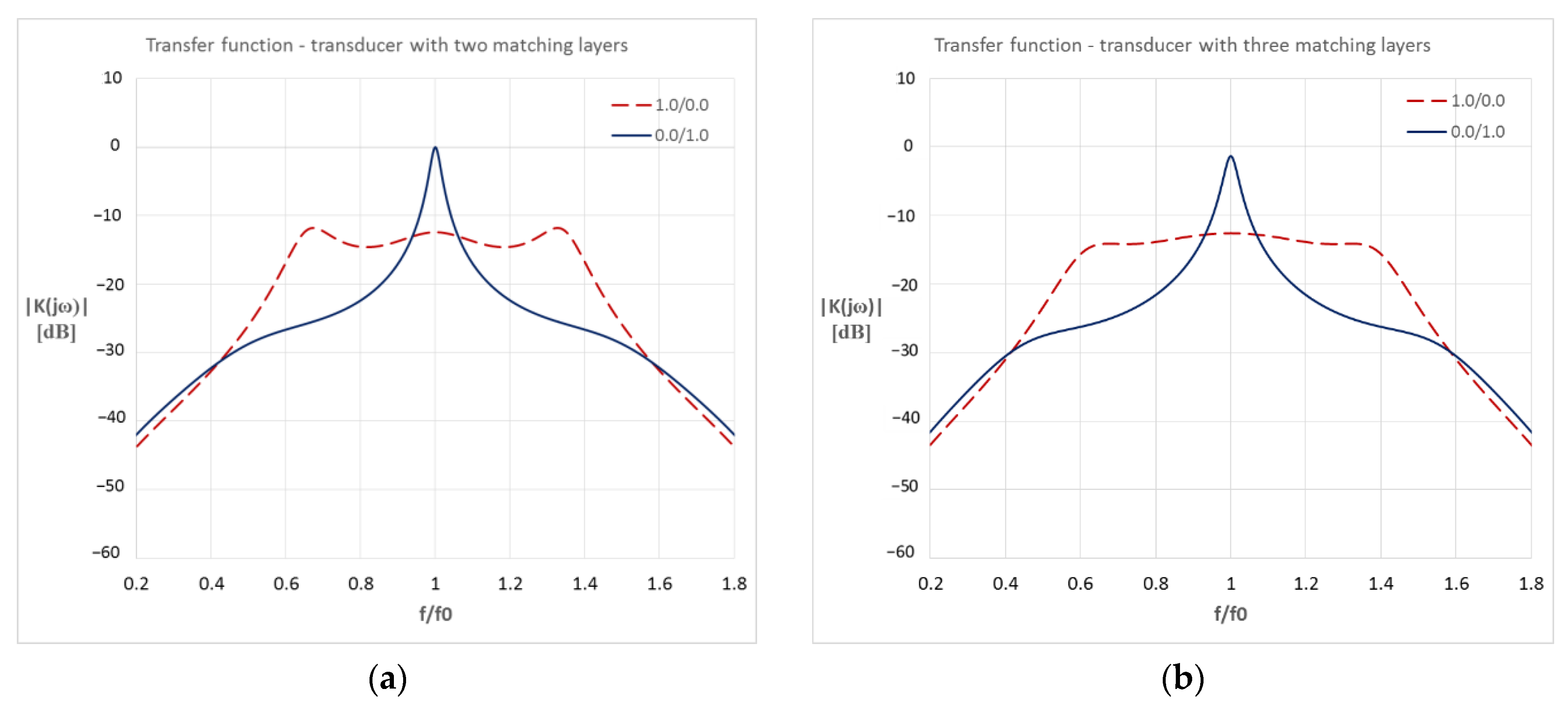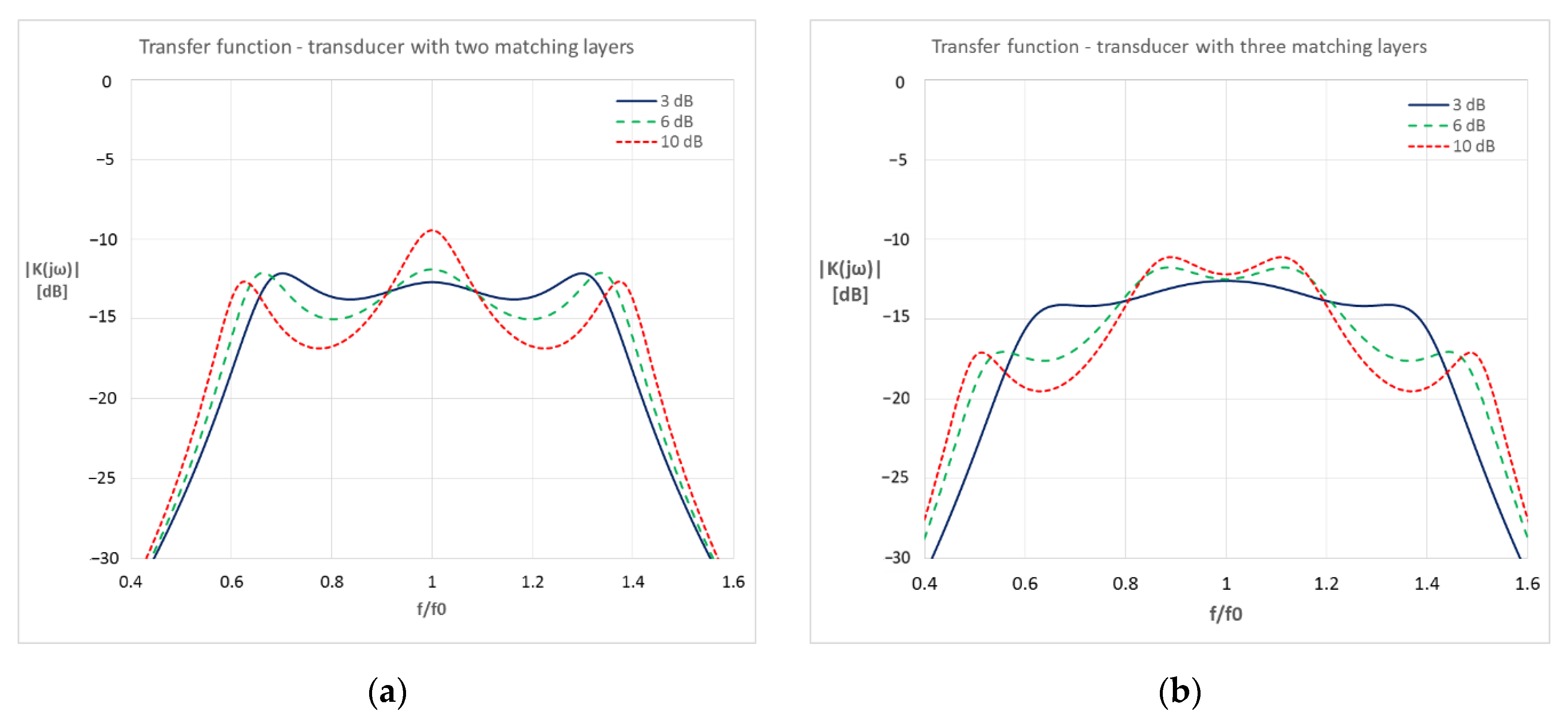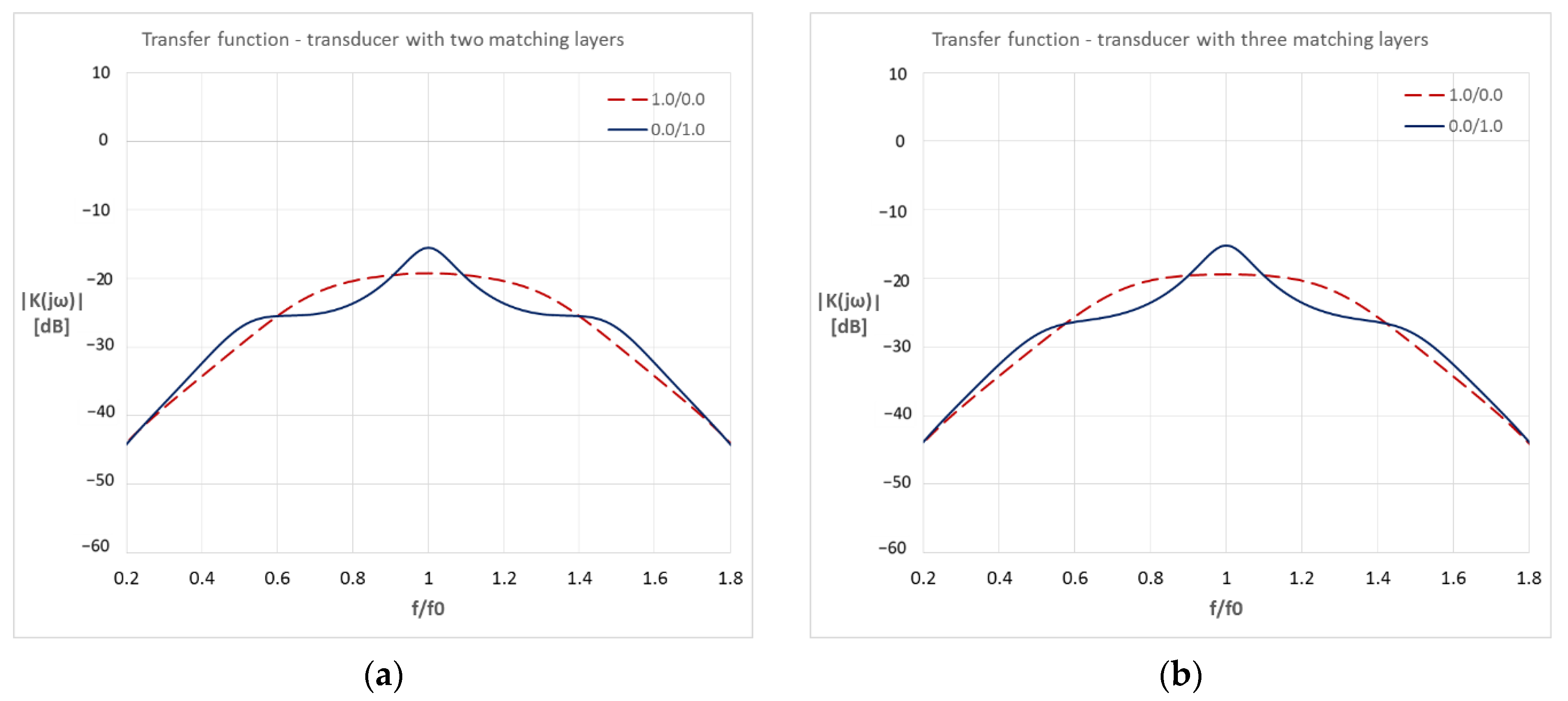1. Introduction
In the case of solutions employing ultrasonic energy, especially in measurement devices operating in pulse modes, a central issue is to select ultrasonic transducers with appropriate parameters. Such parameters include signal transmission effectiveness and signal reception sensitivity, depending on the type of the medium in which the measurement is performed. The parameters of ultrasonic transducers may be adjusted, for example, by appropriately selecting layers which match high impedances of piezoelectric ceramics to significantly lower acoustic impedances of load media (i.e., gases, liquids, biological media). In some applications, especially in the case of liquids (e.g., in hydroacoustics) and biological media (e.g., in ultrasound imaging), the value and the shape of the transfer function play an important role. The state-of-the-art approach used in practice to design transducers with required transfer functions is limited to finding proper materials for the matching layers by means of calculations according to the well-known matching criteria: Chebyshev, Soquet or DeSilets. The Chebyshev criterion [
1] is based on calculating the geometric mean of the impedances surrounding the transducer (according to the long line theory). The Soquet criterion [
2] is based on calculations following the equality condition of the goodness of the electrical and mechanical branches in the equivalent circuit of the transducer, which allows the maximum amplitude of the reflected pulse to be obtained. The DeSilets criterion [
3] is based on analyzing the matching of the impedances in order to allow an optimal pulse shape. It is worth noting that the layer impedances calculated for the above-mentioned criteria differ significantly. With the use of the Chebyshev, DeSilets and Souquet criteria, matching layers are selected on the basis of only acoustic impedance values for individual materials. The choice of a particular criterion depends on the type of transducer application and on its operating conditions.
Publications [
4,
5] describe how the value of the transfer function is affected by both the acoustic impedance of multicomponent matching layers and the thicknesses of individual layers. In particular, the influence of acoustic impedance on the shape of the transfer function has been analyzed in the above-mentioned works, which indicate limited possibilities of selecting appropriate materials for a transducer intended for operation in air. The possibility of shaping the transfer function by changing the thicknesses of the matching layers was also presented. The results of these analyses have shown how significantly the selection of individual materials and their thicknesses affects the shape of the transfer function. Acoustic attenuation of the materials which comprise the matching layers can also be an important factor in the transducer design. Publication [
6] analyzes the influence of the attenuation properties of the material forming the matching layer on the losses in the energy transmitted by the transducer. The presented results indicate that the attenuation of the matching layer has a significant influence, especially in the case of air. When selecting a material for the matching layer, its attenuation may have a greater significance than the impedance value.
Publication [
7] analyzes the possibility for an optimal selection of matching layers for ultrasonic transducers from the perspective of the value of the transmission coefficient. The research focused on identifying the influence of the acoustic impedance and acoustic attenuation coefficient for transducers operated in air and water. Publications [
8,
9] provide examples of how genetic algorithms are used in the selection of matching layers for air-operated transducers. This article presents how a genetic algorithm can be applied in a multiparameter analysis of the possibility to shape the transfer function of ultrasonic transducers intended for operation in various media.
A broader review of the problems related to selecting matching layers for piezoceramic transducers is presented in [
7].
2. Transfer Function of Piezoceramic Transducer
A number of methods allow the analysis and design of piezoelectric transducers with matching layers intended for operation in various media (e.g., solid, liquid, gaseous). These methods employ various mathematical models that describe the behavior of a system consisting of a piezoceramic plate, a matching layer, and a load [
6,
10,
11,
12]. One such model analyzes the operation of the transducer from the perspective of the transmission of electric or acoustic signals in the time domain. The model is based on a system of differential equations describing the relationship between electric and acoustic signals, which, in turn, allows the calculation of the transducer’s response to any excitation, as well as to the calculated transducer input impedance and its transfer function. The transfer function provides a considerable amount of important information regarding the properties of the multilayer transducer system (especially in the case of designing broadband transducers), and it can therefore be used in selecting the matching layers.
Figure 1 shows a physical model of a piezoceramic transducer with multicomponent matching layers. Z
C is the transducer impedance, symbols Z
C1-Z
Cn are the impedances of individual matching layers, Z
T is the impedance of an unlimited medium which receives the energy from the transducer, and Z
b is the impedance of the back layer of the transducer. Symbols l
i are the thicknesses of individual transducer layers.
A piezoceramic transducer with matching layers can be viewed as a linear system. In such a case, the transducer’s transfer function is the Fourier transform of its pulse response. A direct calculation of the Fourier transform for a pulse response is a complex task. Therefore, it is more common for the transfer function to be calculated by applying the Fourier transform to the relevant differential equations which describe how the acoustic velocities of waves propagating in the individual layers of the transducer are related to the changes in the electric charge between the electrodes of the transducer due to its excitation. The following relationship is obtained for a transducer with one matching layer [
13,
14]:
where
The symbols β
b, β
C1 and β
C2 used in the above equations represent the reflection coefficients on the border of the ceramic material and the back surface of the transducer, the ceramic material and the matching layer, and the matching layer and the medium in which the transducer operates, respectively. The above coefficients depend on impedances Z
b, Z
C, Z
C1 and Z
T. The τ and τ
1 symbols represent the delay of the acoustic wave in the piezoceramic material and in the matching layer, respectively. The delay depends on the thickness of a particular layer and on the propagation velocity of the wave in a particular layer. The coefficient h is the piezoelectric constant. In order to calculate the transducer transfer function, a calculation should be performed of the module of function K
C2(jω), as described by relationship (1). Analogical relationships for the transducer with two and three matching layers are described in publications [
4,
5]. The calculations for the above relationships are provided in [
13].
Relationship (1) indicates that an appropriate selection of the reflection coefficients β and delays τ allows the shaping of the attenuation and phase characteristics of the transducer. At certain impedances of the ceramic material and the medium, the transfer function can be shaped by using a system with multicomponent matching layers that have defined impedances and thicknesses. One of the methods for selecting matching layer impedances is to calculate them in accordance with a Chebyshev, DeSilets or Souquet criterion.
Figure 2 shows the transfer characteristics for a transducer operated in air with one or two matching layers, with the layer impedances being calculated in accordance with the above criteria (the assumed thickness of layer l
i was equal to λ/4). These characteristics were compared with the characteristics of the transducer without a matching layer and standardized by the maximum value of this characteristic for the frequency value f
0.
Figure 2 confirms that a change in the number and impedance values of the matching layers allows a certain influence on the shape of the transducer transfer function. However, the impedance values calculated from the Chebyshev, DeSilets or Souquet criteria are theoretical values. Finding a material for the matching layer that has a certain impedance may be problematic.
3. Selection of Matching Layers Using a Genetic Algorithm
When designing ultrasonic transducers, a significant obstacle is to obtain materials with certain acoustic properties (i.e., mainly impedances), which may be used as matching layers. A solution to the above problem may be to treat the selection of matching layers as an optimization task. In such an approach, candidate materials for a matching layer should be selected from the available materials (with certain properties) in order to optimize a selected parameter that describes the quality of the transducer operation in a particular medium. This article discusses the issue of appropriately shaping the transducer’s transfer function. In such a case, the selection of an acoustic matching layer consists of searching the state-space of possible solutions (in this case, various combinations of materials for the matching layer) in order to obtain a certain shape of the function (e.g., a certain bandwidth). When a transducer that has several matching layers is designed from a large number of available materials, the search space may be large, and, therefore, the task may become complex. Solutions to optimization tasks with large search spaces may involve methods based on artificial intelligence, e.g., genetic algorithms. The mechanism behind a classic genetic algorithm can be shown as a series of the following steps:
An initial population is generated randomly;
The population is evaluated (selection). Individuals displaying the best fitness take part in the reproduction process;
Genotypes of the selected individuals are subjected to evolutionary operators:
crossover (recombination of the parent genotypes),
mutation (introduction of minor, random changes to the genotypes).
Creation of a new generation (new population). If the solution is not satisfactory, return to step 2. Otherwise, a solution is obtained.
Publication [
7] presents the application of a genetic algorithm in determining the matching layers for piezoceramic transducers, which are operated in air and in water, with a view to obtaining an optimal transmission coefficient value. The article also discusses some basic terminology related to the implementation of a genetic algorithm for the optimal selection of a transducer’s matching layers.
An important element of the genetic algorithm, which has a significant influence on its effectiveness, is its fitness function. It allows each individual in the population to be evaluated, with the results being used to select the fittest (closest to the optimal solution) individuals for the further steps of the algorithm. The term individual is used to denote a set of task parameters which represent a candidate solution to a problem, and which are encoded in the form of chromosomes. In the case of the problem discussed here, the solution comprises such a combination of k matching layers with defined impedances and thicknesses that allows the optimization of a particular criterion. In this research, the individuals should be evaluated on the basis of the transducer’s transfer function.
Therefore, it is crucial to select criteria which allow the evaluation of the transducer’s transfer function. As the transfer function is used mainly in designing broadband transducers, the transmission bandwidth should be treated as the main criterion. Additionally, when designing a transducer, it is desirable to obtain the flattest possible characteristics within its operating frequency. In some cases, a compromise may be necessary: to increase the transmission bandwidth at the cost of increased unevenness of the characteristics. Here, the unevenness of the characteristics is understood as the difference between the maximum and the minimum value of the transducer’s transfer function in the analyzed frequency range.
Figure 3 shows the relationship between the transmission bandwidth and the unevenness of the characteristics.
Figure 3 shows two characteristics of a transducer with one matching layer, which is operated in water. In the first case, the layer impedance was Z
1 = 4,300,000 Rayl, and in the second case it was Z
2 = 7,250,000 Rayl. The impedance value of the matching layer significantly influences the shape of the transfer function. The effective transducer transmission bandwidth depends on the assumed limit value of the unevenness of the characteristics. Typically, the limit value is assumed to be −3 dB with respect to the maximum value. This is the value assumed in the analysis of the transfer function for the transducer with a layer with impedance Z
1. At Δk
1 = 3 dB, the bandwidth is B
1. In the case of a transducer with a layer impedance Z
2, the assumed value was Δk
2 (greater than Δk
1) and the obtained bandwidth was B
2 (greater than B
1). This example serves as an illustration that the interpretation of the transfer function is not unambiguous and depends on the used assumptions.
A note should be made here that the analysis of the transfer function should also involve the values that the function acquires within the transducer’s operating bandwidth. This can serve as the basis for the evaluation of the effectiveness at which the transducer transmits the acoustic wave to a particular medium. In this case, a compromise is also necessary: an increase in the transducer’s transmission bandwidth is at the cost of a decrease in its effectiveness.
Having involved the above factors, the evaluation of the transducer on the basis of its transfer function was performed by assuming the following relationship (it is considered as a fitness function for the evaluation of the individuals in the genetic algorithm):
where B is the bandwidth (calculated at a defined value Δk) and K
mean is the mean value of the transfer function calculated for bandwidth B.
An appropriate selection of the values of the coefficients α1 and α2 allows the expected shape of the transducer’s transfer function to be manipulated. Increasing the value α1 causes an increase in the transducer’s bandwidth, while increasing the value α2 causes an increase in its effectiveness.
4. Results of Computational Experiments
The main goal of this research is to evaluate the potential for using a genetic algorithm for shaping the transfer function of piezoceramic transducers by appropriately selecting the impedances in the matching layers. The use of a genetic algorithm means that the materials forming the matching layer can be selected from the available materials in such a way that allows the optimization of a selected parameter that describes the operation of a transducer in a particular medium (in this case the expected shape of the transfer function). The analysis was performed for three individual media: air (Z
T = 427 Rayl), water (Z
T = 1.5 MRayl) and a biological medium (skull bone, Z
T = 7.8 MRayl). An assumption was made that the transducer was manufactured from PZT ceramic material that has an impedance of Z
C = 33 MRayl. The analyzed transducer had either two or three matching layers, without load applied to the back side (Z
b = 0). The analysis focused only on the influence of the acoustic impedance of the matching layers on the shape of the transfer function, and therefore assumed a constant thickness of individual layers equal to λ/4. The experiments were performed on a database comprising 96 physically available materials with various acoustic properties. The database was developed with the use of data included in a number of scientific articles concerning the design of ultrasonic transducers, and also data in catalogs from the manufacturers of ultrasonic materials [
11,
15,
16,
17]. The acoustic properties of the materials used in the experiments are shown in [
7]. The analysis of these properties allows us to conclude that the impedance distribution for the available materials is not uniform; the database contains a relatively small number of materials with low and high acoustic impedances. This fact may unfortunately have a negative impact on the obtained results (on the possibility to shape the characteristics in a manner to meet expectations).
The transducer’s transfer function was evaluated with the use of the fitness function described with Equation (4). The first experiments were performed for a transducer operated in air. In this case, a significant difference is observed between the acoustic impedances of the ceramic material and the air (33 MRayl i 427 Rayl, respectively). The main goal of the experiment was to determine the influence of the α
1, α
2 and Δk parameters on the obtained transfer function. The properties of the designed transducer can be influenced by adequately selecting the values of α
1 and α
2. In the case of the combination of α
1 = 1.0 and α
2 = 0.0, the transducer should demonstrate a significant bandwidth, and in the case of the combination of α
1 = 0.0 and α
2 = 1.0, the priority is to obtain a transducer with high effectiveness. A transducer with a wide bandwidth has a lower effectiveness, and, conversely, a transducer with high effectiveness has a limited bandwidth. By changing the values of coefficients α
1 and α
2, a compromise may be reached between the bandwidth and the effectiveness of the transducer.
Table 1 shows the obtained values of the acoustic impedances for individual matching layers with respect to the combination of parameters α
1 and α
2.
Figure 4 shows the corresponding transfer functions. The experiments were performed for the value of coefficient Δk = 3 dB.
The subsequent experiments were performed for a transducer operated in water.
Table 2 and
Figure 5 show the results for the following combinations of coefficients: α
1 = 1.0/ α
2 = 0.0 (bandwidth optimization) and α
1 = 0.0/α
2 = 1.0 (effectiveness optimization) and for the assumed value of coefficient Δk = 3 dB. The experiments were also performed for other combinations of coefficients α
1 and α
2. The resultant transfer function curves, however, were very similar to one of the characteristics shown in
Figure 5. In this case, it was impossible to obtain “intermediate” transfer function characteristics, which was also the case with the transducer operated in air.
The analysis of the characteristics shown in
Figure 5 allows us to conclude that the difference in the transfer function value between the two characteristics for frequency f
0 is approximately 10 dB. Therefore, in the case of a transducer with high bandwidth, the loss of effectiveness may be viewed as insignificant and acceptable. For this reason, the bandwidth was increased by allowing a higher unevenness of the characteristics.
Table 3 and
Figure 6 show the results for the values of Δk equal to 3 dB, 6 dB and 10 dB.
Subsequently, the analysis focused on the operation of the transducer in the biological medium. Because most of the tissues that are important in the diagnostic procedures have an acoustic impedance similar to that of water, the research was performed for the skull bone (Z
T = 7.8 MRayl). As in the case of water, the experiments were performed for the following combinations of coefficients: α
1 = 1.0/α
2 = 0.0 (bandwidth optimization) and α
1 = 0.0/α
2 = 1.0 (effectiveness optimization) and for the assumed value of coefficient Δk = 3 dB. The results are presented in
Table 4 and in
Figure 7.
When analyzing the results, consideration should be paid to the following aspects: different combinations of α1 and α2 do not result in significantly different transfer functions, and the obtained characteristics differ significantly from the potentially optimal transfer functions that can be obtained for theoretical acoustic impedance values in the case of matching layers calculated on the basis of the Chebyshev, DeSilets or Souquet criteria. This phenomenon may be due to the limited number of materials included in the database that was used in the experiments. The database includes only 8 material types which have impedance values within the range of 33 MRayl (ceramics) and 7.8 MRayl (bone).
5. Conclusions
This article demonstrates that the application of a genetic algorithm allows the materials for the matching layer to be selected in such a way that enables an appropriate shaping of the transfer function of the piezoelectric transducer. Depending on the parameters of the proposed fitness function, the calculations may include the following factors: transmission bandwidth, mean value, and the unevenness of the characteristics in the analyzed band. The analysis was performed for a transducer operated in three different media: air, water and a biological medium (skull bone). The investigations focused on a transducer with either two or three matching layers. The experiments were performed on a database comprising 96 physically available materials with various acoustic properties. The materials in this database have a non-uniform distribution of impedances, with a relatively small representation of materials with low and high impedances. The potential for designing a transducer that has the required transfer function should be significantly improved after the database of materials is expanded.
The main advantage of the proposed method, which employs a genetic algorithm, is the optimal selection of materials for matching layers from among the physically existing materials. This approach is fundamentally different from the existing methods of the matching layer selection. It assumes the calculation of the acoustic impedance of the matching layer based on a particular criterion and then the selection or development of a material with properties that meet the above criteria. However, it should be noted that the development of a material with specific acoustic properties is difficult for technological reasons. By using different matching functions, the genetic algorithm allows transducers with desired parameters to be designed to work in different media.

